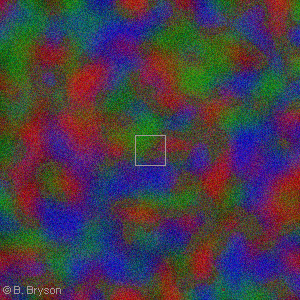Scale: 10-16 meters = 100 am = 100 attometers
Inside a ProtonThis image is a conceptual representation of the interactions of the three quarks that make up a proton -- two up quarks and one down quark. Evidence so far indicates that quarks are permanently bound within the particles they compose. Indeed, the energy required to separate quarks within a proton or neutron is enough to create other quarks and antiquarks -- all bound tightly within a slew of other particles created in high-energy collisions. How can one be so confident of the quark model when no one has ever seen an isolated quark? There are good reasons for the lack of direct observation. Apparently the color force does not drop off with distance like the other observed forces. It is postutated that it may actually increase with distance at the rate of about 1 GeV per fermi. A free quark is not observed because by the time the separation is on an observable scale, the energy is far above the pair production energy for quark-antiquark pairs. For the U and D quarks the masses are tens of MeV so pair production would occur for distances much less than a fermi. You would expect a lot of mesons (quark-antiquark pairs) in very high energy collision experiments and that is what is observed. Copyright © 2016 by Bruce Bryson |
